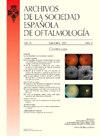双侧角膜溃疡:1例报告
Q3 Medicine
Archivos De La Sociedad Espanola De Oftalmologia
Pub Date : 2025-06-10
DOI:10.1016/j.oftal.2024.12.009
引用次数: 0
摘要
细菌性角膜炎是全世界单眼失明的主要原因之一。以下病例描述了一例由克雷伯氏菌引起的双侧细菌性角膜炎患者,克雷伯氏菌是一种革兰氏阴性菌,在细菌性感染性角膜炎病例中经常被忽视。患者是一名20岁男性,既往有过敏性角膜结膜炎和圆锥角膜病史,在不当使用其隐形眼镜后出现上皮缺损。最初,患者使用眼部润滑剂。然而,他的视力迅速恶化,伴有上皮缺损的扩大和双侧间质浸润的出现。由于对经验性抗菌治疗的反应不佳,从隐形眼镜中获得培养物,鉴定出K. oxytoca是病原体。抗生素谱显示对环丙沙星等广泛使用的抗生素有耐药性。根据这些结果,开始了靶向抗菌治疗,导致显着的临床改善和大量的解剖和视觉恢复。本病例强调了在免疫功能正常的患者中认识到叶绿梭菌潜在侵袭性的重要性,它可引起严重的眼部感染,特别是在有戴隐形眼镜等危险因素的个体中。它还强调了微生物培养和抗生素图的迫切需要,以指导有效的治疗,考虑到这种微生物的可变耐药模式。本文章由计算机程序翻译,如有差异,请以英文原文为准。
Úlcera corneal bilateral por K. oxytoca: reporte de un caso
Bacterial keratitis is one of the leading causes of monocular blindness worldwide. The following case describes the case of a patient with bilateral bacterial keratitis caused by Klebsiella oxytoca, a gram-negative bacterium often overlooked in cases of bacterial infectious keratitis. The patient is a 20-year-old man with a past medical history of allergic keratoconjunctivitis and keratoconus who developed an epithelial defect following improper handling of his contact lenses. Initially, the patient was managed with ocular lubricants. However, he experienced a rapid and aggressive deterioration in visual acuity, with an expansion of the epithelial defect and the appearance of bilateral stromal infiltrates. Due to the poor response to empirical antimicrobial therapy, cultures were obtained from the contact lenses, which identified the presence of K. oxytoca as the causative agent. The antibiogram revealed resistance to widely used antibiotics such as ciprofloxacin. Following these results, targeted antimicrobial therapy was initiated, leading to significant clinical improvement and substantial anatomical and visual recovery. This case underscores the importance of recognizing the potential aggressiveness of K. oxytoca in immunocompetent patients, which can cause severe ocular infections, particularly in individuals with risk factors such as contact lens wear. It also highlights the critical need for microbiological cultures and antibiograms to guide effective therapy, given the variable resistance patterns of this microorganism.
求助全文
通过发布文献求助,成功后即可免费获取论文全文。
去求助
来源期刊

Archivos De La Sociedad Espanola De Oftalmologia
Medicine-Ophthalmology
CiteScore
1.20
自引率
0.00%
发文量
109
审稿时长
78 days
期刊介绍:
La revista Archivos de la Sociedad Española de Oftalmología, editada mensualmente por la propia Sociedad, tiene como objetivo publicar trabajos de investigación básica y clínica como artículos originales; casos clínicos, innovaciones técnicas y correlaciones clinicopatológicas en forma de comunicaciones cortas; editoriales; revisiones; cartas al editor; comentarios de libros; información de eventos; noticias personales y anuncios comerciales, así como trabajos de temas históricos y motivos inconográficos relacionados con la Oftalmología. El título abreviado es Arch Soc Esp Oftalmol, y debe ser utilizado en bibliografías, notas a pie de página y referencias bibliográficas.
 求助内容:
求助内容: 应助结果提醒方式:
应助结果提醒方式:


